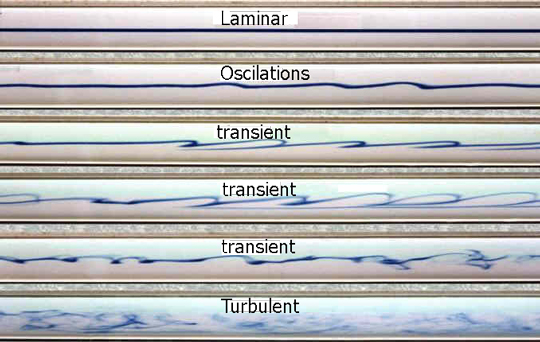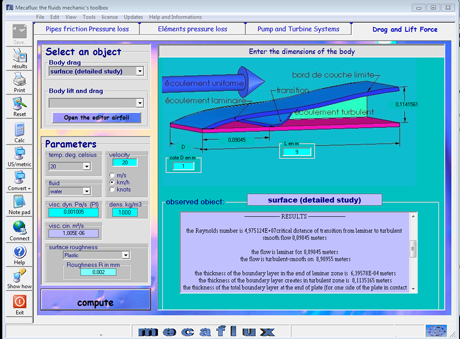Depending on the flow regime pressure head loss vary as the behavior of the fluid changes. Example of turbulent flow regime in a pipe section:
Friction and viscosity of the fluid causes difference of velocity, according to the distance of the walls of the pipes. The speed variation generates turbulence and losses.
flow Regimes in a pipe:

To date no equation can fully assess the pressure drop whatever the type of flow. it is therefore necessary to determine the flow regime to choose the equation that is suitable for calculation of the coefficient of losses.
With Mecaflux standard,
- in a pipe:
The flow regimes vary according to:
Velocity, viscosity, pipe diameter, roughness, density.
The flow regime is given by the Reynolds number: Re
- If Re < 2000 the flow regime is laminar, we use the formula of Poiseuille laminar flow to find the coefficient of major losses.
- If 2000<Re<3000 the regime is transient. (it can switch from one state to the other, it is good to do the calculation in the two states to assess the possible behavior of the fluid)
- If 2000 < Re< 105 the flow is turbulent-smooth, use the Blasius formula for turbulent-smooth flow to find the coefficient of major head loss,
- If 2000 < Re the flow is turbulent, to find the coefficient of head loss , Colebrook can be used in all cases of turbulent flow
These values of Reynolds transition are approximate,because transitions are gradual and can be activated by irregularities of surface states.
the flow regime in the ducts is determined, depending on your settings of pipes: roughness, flow, diameter...:
- On a flat plate or surface:
Frictional forces also depend on the flow regime, the regime of laminar to turbulent varies depending on the distance to the leading edge.
We distinguish a critical distance (x critic) at which the transition between laminar and turbulent occurs. the boundary layer thickness varies depending on the flow regime and the distance from the leading edge.
With Mecaflux standard, the Regime of flow on a plate is determined using the detailed study of a plate. you can evaluate the thickness of the boundary layer, the critical distance transition of laminar flow to turbulent, depending on the fluid velocity and surface roughness of your choice.


